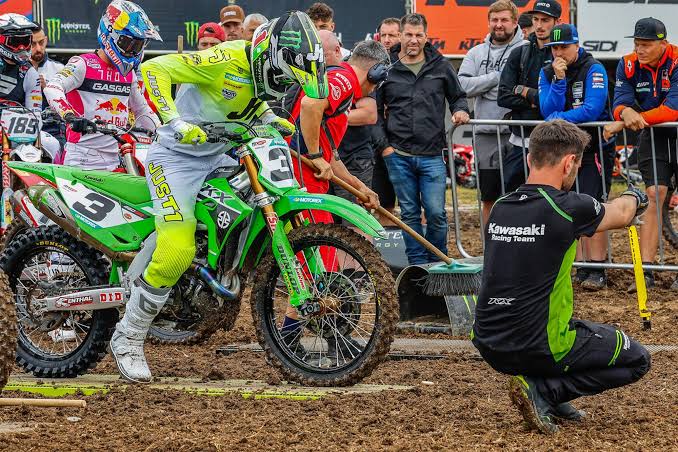The Green Silence: Did Kawasaki Just Go Completely Dark?
The motorcycle world was holding its collective breath.
It had started six months ago with a blurry photo. Posted anonymously to a fringe dirtbike forum, it showed what looked like a modern motocross frame—distinctively green—with a telltale expansion chamber poking out the side. No other big brand used that iconic lime hue. The speculation engine roared to life.
“Kawasaki’s bringing back the 2-stroke,” one comment read.
“I’ll believe it when I hear it scream,” said another.
Then came the video. A short, shaky clip of a bike absolutely shredding a test track. The sound unmistakable—a piercing, high-pitched symphony of 2-stroke fury. Not a modded KX500. Something new. Slimmer. Faster. The powerband hit like a lightning strike.
And then… nothing.
No press release. No teasers. Kawasaki’s official channels stayed dead quiet. Instagram: silent. Twitter: generic promos. YouTube: last post about electric scooters.
In an age of constant leaks and “accidental” social media reveals, the vacuum was almost deafening.
People noticed. And the theories began.
—
The Conspiracy Riders
“It’s the EPA,” muttered Cole Decker, a mechanic and small-time motocross influencer, on his late-night podcast. “They’re trying to stop it before it gets out. Look, there’s no way a major OEM greenlights a new 2-stroke unless they’ve figured out emissions. Maybe they cracked it—and now the Feds are blocking them.”
“Bro, it’s deeper than that,” his guest replied. “It’s Big Four-Stroke. KTM, Honda, Yamaha—they don’t want Kawi back in the 2-stroke game. They’re sitting cozy. If Kawasaki brings back a full-factory 2T, it’s game over. So, what if there was pressure… you know, from the inside?”
Others speculated it was internal drama. A high-up engineer left suddenly. A patent for electronically controlled fuel-injection on a 2-stroke had gone dark on the database. Something was up.
Yet still—no updates.
—
The Underground Whispers
Whispers came out of Japan, too. A message posted by a self-proclaimed “supplier insider” claimed a new model, codenamed Project Komorebi, had been in quiet development since 2021. The message was swiftly deleted. Too swiftly.
Then a Canadian dealer received an unmarked crate with “testing unit – do not display” stamped in English and Kanji. Inside? A parts catalog unlike anything they’d seen.
Aluminum frame, carbon subframe. Electronically controlled power valve. Clean, fuel-injected 2-stroke motor—250cc and possibly a 300 variant. There were no VINs. No model names.
The crate was reportedly picked up by men in plain clothes two days later. “They just smiled and said it wasn’t ready yet,” the dealer claimed. “Then they were gone.”
—
The Silence Becomes a Message
Kawasaki fans, desperate for answers, began digging. Some believed the silence was the marketing campaign.
On Reddit, a theory emerged: that Kawasaki was orchestrating a guerrilla reveal—building buzz through frustration and mystery. It worked for Tesla, right?
#KXReborn started trending.
A TikTok challenge emerged: “Where’s the 2-stroke?” Riders donned green gear and pretended to “search” remote deserts, tracks, even Kawasaki dealerships.
Kawasaki, eerily, didn’t engage.
Then came the strangest sign yet. In March, the homepage of Kawasaki’s official motocross page was updated for less than five minutes.
Just a black screen. White text. Two sentences:
> “Sometimes you have to go silent to hear the scream.
June 11th.”
Then it vanished.
—
June 11: Today
That date is today. And the motorcycle world is still holding its breath.
At 9 a.m. JST, all Kawasaki sites worldwide went offline.
Instagram scrubbed clean.
Even dealership portals returned a 404.
By 9:02, people were watching livestreams of Kawi dealerships, hoping for a glimpse—anything.
And then, at 9:10 a.m., the screen turned on.
A global broadcast. Minimalist. A dirt track. Overhead drone shot. Nothing moving.
Then a single rider appeared at the edge of the frame.
The bike was unmistakably Kawasaki. The exhaust pipe curved like a question mark.
The rider didn’t speak. Just twisted the throttle.
The scream pierced the silence.
No music. No commentary. Just one minute and thirty-seven seconds of pure riding footage. Dust. Roost. Unfiltered glory.
Then the screen faded to black, revealing:
> KX250X2
Two-Stroke. Fuel Injected.
Fall 2025.
The world went nuts.
—
The Aftershock
Forums crashed. Instagram reels flooded with reaction videos. One older rider cried on camera: “I waited twenty years. I thought they’d never do it.”
A press release followed an hour later—short, clinical, but confirming what the world had now seen:
Two models: the KX250X2 and the KX300X2.
Transfer port fuel injection and oil injection system.
Race-ready out of the crate.
Full launch at EICMA in November.
Kawasaki had gone dark—not because they had nothing to say, but because they had everything to show.
The silence was the scream before the scream.
—
Epilogue: The Long Game
As journalists scrambled to dissect what just happened, a quote from a Kawasaki engineer surfaced in an industry interview from 2019. It had been largely ignored back then.
> “Everyone’s chasing quiet. We’ve been working on a way to make noise… that matters.”
Now, it made sense.
Kawasaki didn’t just bring back a 2-stroke. They resurrected a legend by doing what no one else dared: saying nothing, until they had everything to say.
The green flame was back. And it was screaming.
